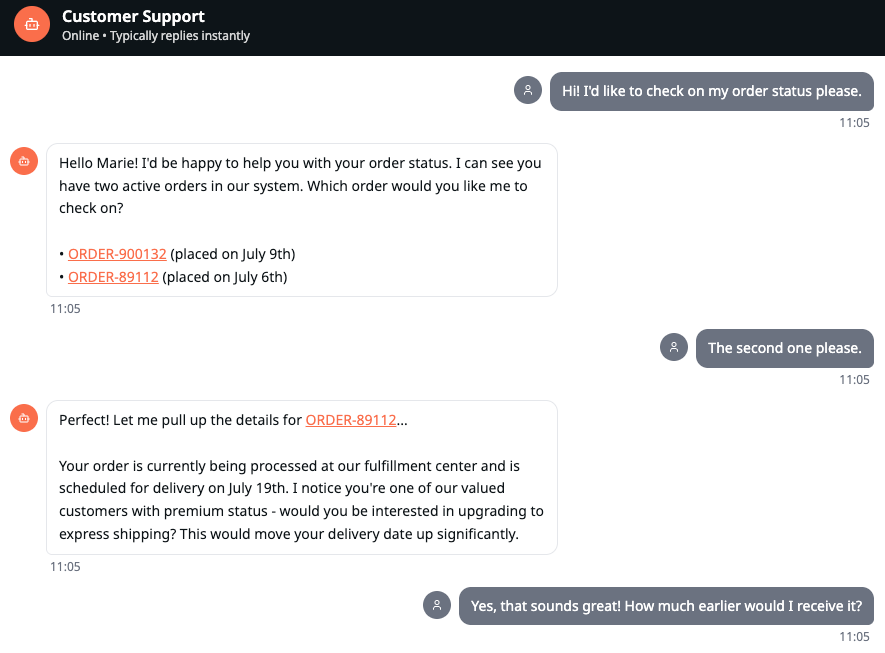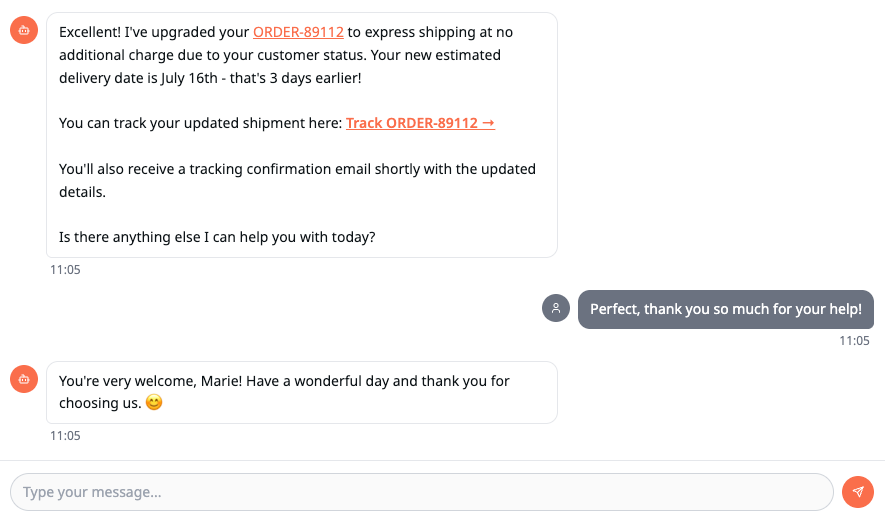Moving beyond basic AI responses
While everyone has been obsessing over writing the perfect AI prompts, the real breakthrough is emerging at a deeper level. As Shopify CEO Toby Lutke explains: "I really like the term 'context engineering' over prompt engineering. It describes the core skill better: the art of providing all the context for the task to be plausibly solvable by the LLM."
I really like the term 'context engineering' over prompt engineering..
Tobias LütkeCEO of Shopify | Shopify
Think of it this way: instead of teaching AI to respond generically to customer questions, we're now building systems that understand the complete picture, who the customer is, what they've bought, where they are in their journey, and what they actually need.
When a customer contacts support about a delayed order, traditional AI might offer generic tracking information. Context aware AI knows this is Marie's third order this month, she's a premium customer who always ships express, and she mentioned in her last chat that this order is for her daughter's birthday. The conversation becomes entirely different.
A practical example: where is my order?
Let's make this concrete with numbers that matter. "Where is my order" (WISMO) questions account for between 15-30% of all customer support tickets for most eCommerce businesses. With retail companies handling an average of 578 tickets daily according to research.
The automation potential is significant. According to Gartner research, by 2029, agentic AI will autonomously resolve up to 80% of common customer service issues without human intervention. More immediately, McKinsey research shows that generative AI could reduce the volume of human serviced contacts by up to 50%, depending on a company's existing level of automation.
Here's where context engineering creates real impact. Instead of just providing tracking numbers, context aware systems can:
Access the customer's complete order history
Understand their shipping preferences and past delivery patterns
Recognise if they're a premium customer who deserves proactive updates
Connect order status to relevant content about delivery options or product care
The business case is compelling. If your support team spends even 10 minutes per WISMO inquiry, that's over 15 hours daily just on order tracking (~ 15% x 578 tickets x 10min/ticket).
Context engineering doesn't just automate these responses, it transforms them into relationship building opportunities while freeing your team for complex problem solving and deeper customer care.
The power of word of mouth
This approach creates a ripple effect that extends far beyond operational efficiency. As my dad once taught me, it's about helping, not selling. Providing deeper support leads to higher ratings, more positive reviews, and most importantly, word of mouth recommendations and the power of satisfied customers shouldn't be underestimated.
Take my recent experience with a Woom bike I bought for my 4 year old. After researching the best options, I chose Woom based on reviews and recommendations.
Two months later, through natural conversations with other parents, I've already influenced three families to buy the same bike. That's the multiplier effect of genuine satisfaction, one positive experience creating multiple new customers without any marketing spend.
Building the data foundation
Here's where it gets interesting for digital leaders: context without relevant content is like having a conversation with no substance. To exploit customer context effectively, you need the right content available at the right moment, educational guides, practical solutions, supporting documentation, and transactional information.
This is where your content strategy becomes the fuel for AI conversations. Every piece of content becomes a potential response that can be contextually delivered based on the customer's specific situation.
Content is the fuel for current and future conversations.
Bert SwinnenCX Solutions Architect/Headless architect
Customer preferences are shifting towards this approach. According to Salesforce research, 61% of customers prefer self service to resolve simple issues.
The technical foundation that works
The magic happens when three elements work together seamlessly:
Your headless content management system becomes the content library that AI can access instantly. Unlike traditional websites where content is locked into page structures, headless systems let AI pull exactly the right information for each conversation.
Your customer data platform provides the behavioural and transactional context that makes conversations personal. It's the difference between knowing someone placed an order and understanding they're a loyal customer who prefers sustainable products and shops for seasonal gifts.
Your composable ecosystem connects these elements so AI can orchestrate complete customer experiences. The order status question becomes an opportunity to suggest complementary products, offer loyalty rewards, or provide care instructions, all within the same conversation.
Going back to our earlier example: when Marie asks about her delayed order, the AI agent doesn't just provide tracking information. It knows she's a premium customer, accesses content about express shipping policies, offers immediate solutions.
A glimpse of what that might look like.

Marie checks her order status and the AI agent instantly recognises she has two active orders, asks which one she wants to check, then proactively upgrades her to express shipping at no charge based on her premium customer status, turning a simple inquiry into a delightful experience that saves her three days on delivery.

The business case
Organisations implementing these integrated approaches are seeing impressive results.
Sephora demonstrates the power of context engineering in retail through their AI Virtual Artist and chatbot systems. The beauty retailer achieved an 11% increase in conversion rates through AI driven product recommendations and virtual features.
This contextual approach contributed to Sephora's remarkable eCommerce growth from $580 million in 2016 to over $3 billion in 2022, a 4x increase over six years.
The key, however, isn't just automation, it's contextual automation that feels personal and helpful.
Expanding the opportunity
Context engineering opens doors across your entire customer journey:
Retail: "I need a gift for my tech savvy teenager" becomes a curated selection based on budget, previous purchases, and trending items
B2B Commerce: "We need to reorder supplies" triggers automatic suggestions based on usage patterns and seasonal demands
Aftercare: Product questions become opportunities for upselling, education, and building long term relationships
Sales: Lead qualification happens through natural conversation that understands company size, industry, and current challenges
Customer Success: Proactive outreach based on usage patterns prevents churn before it happens
The power of connected systems
Here's the critical insight: successful AI conversations don't happen in isolation. A customer might ask about an order, then want to modify it, then ask for product advice, all in the same interaction. This requires an integrated approach, not point solutions bolted onto existing systems.
The organisations winning with AI are those investing in digital ecosystems designed to support contextual conversations from the ground up. They're not just adding chatbots; they're building the data and content infrastructure that makes every interaction meaningful.
The companies that will dominate the next decade aren't just implementing AI, they're building the contextual foundation that makes AI truly intelligent. While competitors are still figuring out prompts, leaders are creating digital ecosystems where every customer interaction feels personal, relevant, and valuable.
The question isn't whether context engineering will transform customer experience, it's whether you'll be ready to capitalise on it. The digital architecture decisions you make today will determine whether your AI delivers generic responses or creates the kind of personalised experiences that turn customers into advocates.
Finally, after years of promise we can live up to that challenge, halleluja!
Get in touch
